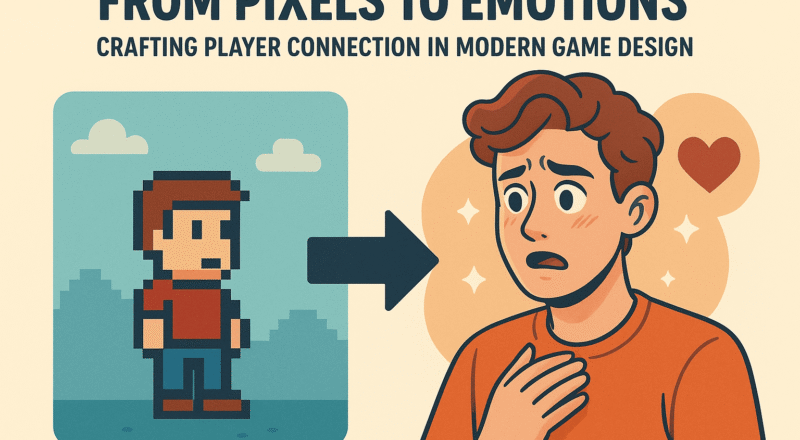Game development has always been about more than just mechanics and graphics. At its heart lies a question: how do we make players feel something? Whether it’s the thrill of victory, the sting of loss, or the quiet joy of exploration, emotions are the invisible threads that bind players to the digital worlds we create.
As production pipelines grow more complex, delivering these emotionally rich experiences increasingly depends not only on internal creativity but also on highly specialized external teams. Many studios now collaborate with expert partners to handle art, animation, narrative support, and even entire gameplay systems—an approach highlighted in recent analyses of the Best Game Development Outsourcing Companies in 2026 (https://www.linkedin.com/pulse/best-game-development-outsourcing-companies-2026-industry-observer-tzige/). These partnerships allow developers to focus on what truly matters: crafting experiences that resonate on a human level.
In modern game design, the challenge is no longer just about rendering lifelike visuals—it’s about building worlds that evoke real emotion, regardless of whether they are created by in-house teams, outsourced specialists, or a blend of both.
The Evolution: From Technical Feats to Emotional Journeys
In the early days of gaming, developers focused on overcoming technical limitations. Games like Tetris or Pac-Man relied on simple mechanics and abstract visuals, yet they still managed to evoke tension, excitement, and satisfaction. As technology advanced, so did expectations. High-resolution textures, realistic physics, and cinematic storytelling became the norm. But players quickly discovered that technical brilliance alone doesn’t guarantee emotional engagement.
Today, the most memorable titles—whether indie gems or AAA blockbusters—are those that balance technical mastery with emotional depth. Journey, The Last of Us, and Celeste are prime examples: they don’t just look good, they feel meaningful.
Why Emotions Matter in Game Design
Emotions transform a game from a pastime into an experience. They:
- Increase immersion: Players forget they’re holding a controller and instead feel part of the world.
- Strengthen memory: Emotional moments are remembered long after mechanics fade.
- Encourage replayability: Players return not just for gameplay, but to relive feelings.
- Build community: Shared emotional experiences spark discussions, fan art, and long-lasting fandoms.
In short, emotions are the glue that keeps players invested.
Techniques for Crafting Emotional Connection
1. Narrative Design
Storytelling is the most direct path to emotion. Strong characters, moral dilemmas, and unexpected twists can make players laugh, cry, or reflect. Importantly, narrative design in games is interactive: players don’t just watch—they participate. Giving players agency in shaping the story amplifies emotional impact.
Example: In Mass Effect, choices affect relationships and outcomes, making players feel responsible for their crew’s fate.
2. Music and Soundscapes
Audio is a powerful emotional driver. A swelling orchestral score can inspire awe, while silence can create tension. Dynamic soundtracks that adapt to player actions deepen immersion.
Example: In Undertale, different musical themes reflect character personalities, subtly guiding player emotions.
3. Visual Symbolism
Beyond realism, visuals can carry symbolic weight. Color palettes, lighting, and environmental design can evoke moods. A desolate landscape communicates loneliness; warm tones suggest safety.
Example: Journey uses vast deserts and glowing horizons to symbolize both isolation and hope.
4. Gameplay Mechanics
Mechanics themselves can be emotional. Struggle, reward, and risk all trigger feelings. Designing mechanics that mirror emotional states—like difficulty spikes during narrative tension—creates synergy between gameplay and story.
Example: In Celeste, climbing a mountain becomes a metaphor for overcoming personal struggles, with mechanics reinforcing the theme.
5. Player Agency and Choice
Allowing players to make meaningful decisions fosters emotional investment. Choices should carry weight, not just cosmetic differences. When players feel their actions matter, emotions naturally follow.
The Role of Empathy
Modern game design increasingly emphasizes empathy—helping players understand perspectives different from their own. Games like Hellblade: Senua’s Sacrifice simulate mental health struggles, while Papers, Please places players in morally complex roles. These experiences go beyond entertainment, offering insight into human conditions.
Challenges in Emotional Game Design
- Balancing fun and depth: Too much emotional weight can overwhelm; too little feels hollow.
- Avoiding manipulation: Forced sentimentality risks alienating players.
- Cultural differences: Emotions resonate differently across cultures, requiring sensitivity in design.
The Future: Emotion-Driven Innovation
Emerging technologies promise new emotional frontiers:
- AI-driven NPCs that respond dynamically to player behavior.
- VR and AR experiences that blur the line between reality and fiction.
- Procedural storytelling that adapts narratives to individual players.
As these tools evolve, the potential for deeper emotional connection grows exponentially.
Conclusion
Modern game design is no longer just about pixels—it’s about people. By weaving narrative, mechanics, audio, and visuals into cohesive emotional experiences, developers create worlds that players don’t just play, but feel. The future of gaming lies in empathy, connection, and the ability to transform digital interactions into human stories.
When players put down the controller and still think about the journey they’ve taken, that’s when game design transcends technology. That’s when pixels become emotions.
